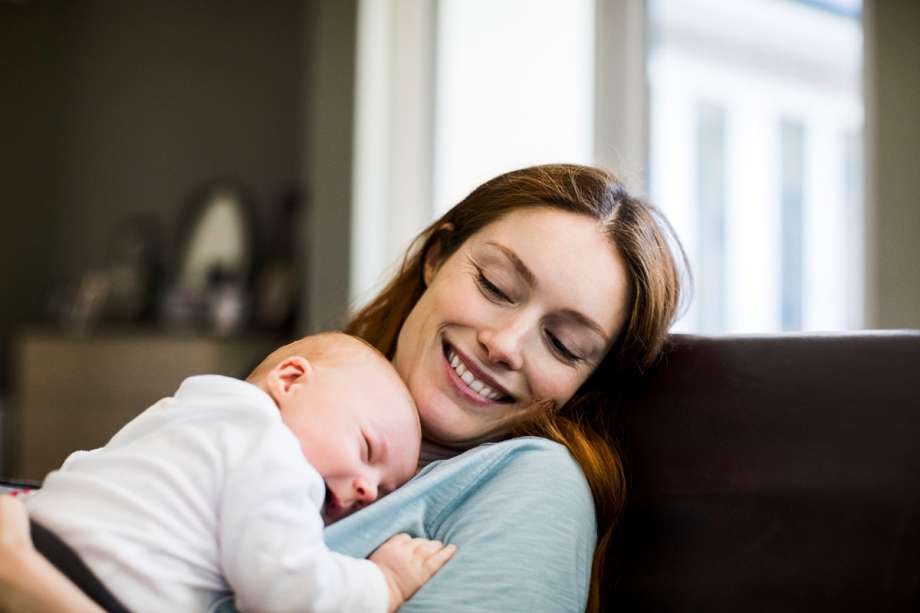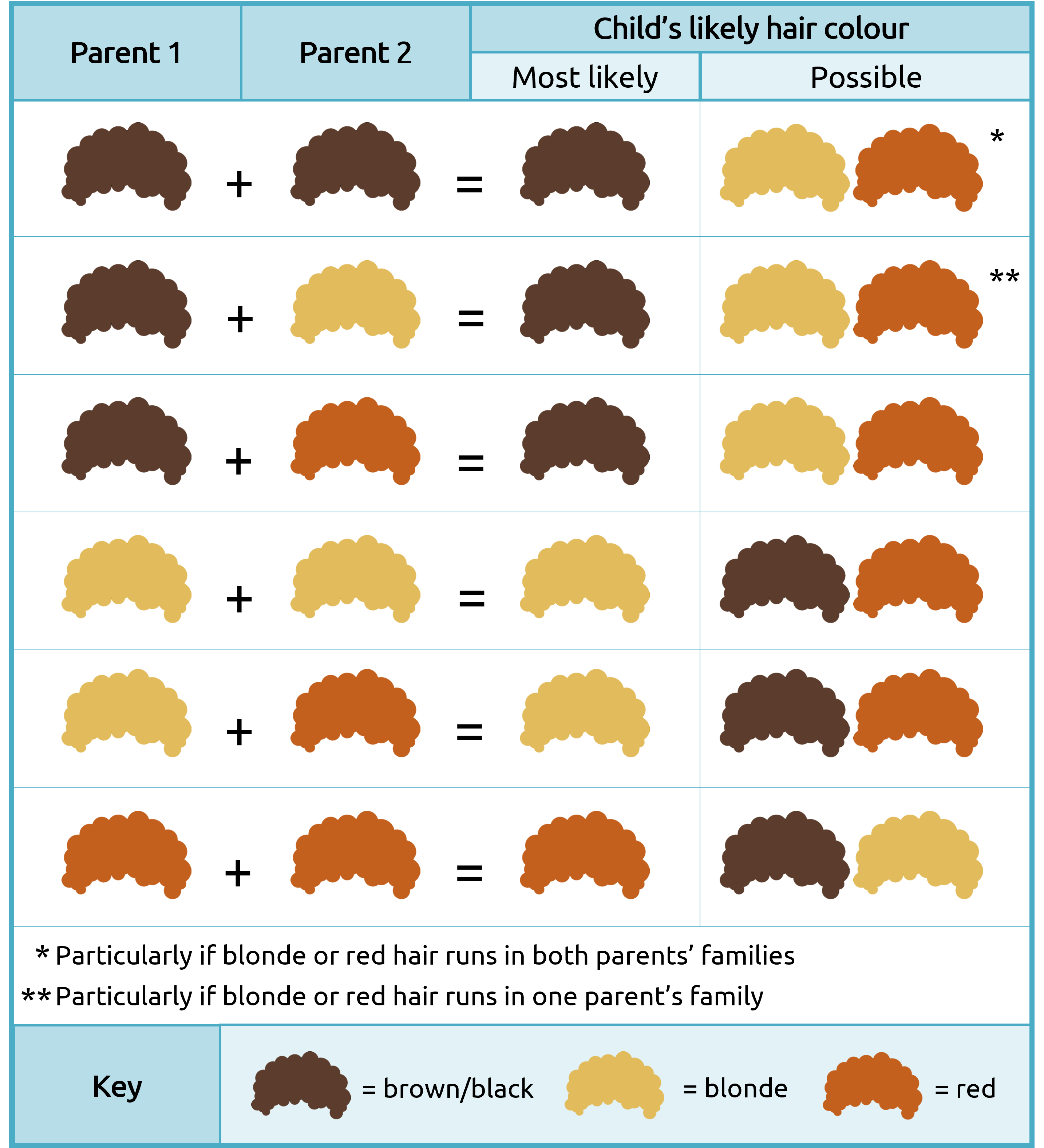What Color Hair Will My Baby Have? (A Guide to Hair Color Genetics)

What will your baby look like? Baby hair color and baby eye color are some of the most common things expecting parents wonder about. While there is no sure bet, you can make some good guesses about your future child's hair color with the right information.
Will My Baby Inherit My Hair Color?
To understand how baby hair color works, you will need to understand some basic genetics. Your genetic code consists of tens of thousands of directions that tell your body how to grow, called genes. Genes are stored inside chromosomes and determine everything from blood type to biological sex to a baby's eye color to a baby's hair color.
Use This Chart To Predict Your Baby’s Hair Color
Now let’s take a look at how we can use genetics to guess your baby’s hair color. To determine what possible hair colors your baby will have based on mom and dad’s hair, use our Baby Hair Color Prediction Chart below and read further for a more detailed explanation of each hair color probability.

Hair Shades and Pigmentation
In truth, the genetics of hair color are just a little more complicated than your basic biology class might claim. Hair gets its color from pigment, and the amount of pigment in the hair affects its exact shade. So we are not really looking at completely separate hair color genes, but rather differing amounts of the same kind of pigment: melanin.
Not only that but the amount of melanin present changes throughout life. A single person may have different colored hair at different ages. Generally, we see light hair earlier in life and dark hair towards adulthood.
Two types of pigment give hair its color: eumelanin and pheomelanin.[1]
Eumelanin makes hair brown or black hair, and the amount of eumelanin present determines how dark the hair is. Smaller amounts of eumelanin make a person’s hair blonde, while larger concentrations make it brown. A subtype of eumelanin makes hair black (interestingly, smaller concentrations of this subtype result in white hair).
Pheomelanin causes hair to look red or orange. All humans have some pheomelanin in their hair, but true redheads have little to no eumelanin. Mixes of eumelanin and pheomelanin lead to auburn or strawberry blonde hair.
Human hair color comes in a variety of shades depending on the particular mix and concentration of pigments. The Fischer-Saller scale, used in physical anthropology and medicine, identifies a variety of shades on the spectrum between light and dark, red and brown.[2]
The categories identified on the Fischer-Saller scale range from very light (A-E), through light (F-L), light brown (M-O), brown (P-T), and finally to brown-black and black (U-Y).
A separate range specifies red and red-blonde (I-VI). The scale also identifies black, gray from age, white from age, and white from albinism.
Eumelanin genes are not recessive or dominant, but either “off” or “on” The more "on" genes a baby gets from either their mother or father, the darker that baby’s hair color. Hair color is controlled by as many as 21 different genes.[3]
The gene code that you carry is called your genotype. The traits that you actually present are your phenotype. Parts of the genotype that do not show up in your appearance can still be passed along to your children.
Which Parent Determines Your Baby's Hair Color?
Baby hair color is determined by which particular hair color genes are turned “on” or “off”. Who the child "gets it from" really depends on the parents’ hair color and a bit of chance. For example, if one parent has dark brown hair, and the other has light brown hair, the baby will most likely get their hair color from the parent with darker hair. But it is not always so simple.
Let’s apply what we have learned about genetics to hair color. We will use brown and blonde hair in our example and later discuss other common hair colors.
Generally, dark-hair chromosomes are more common. Children with two brown-haired alleles will have brown hair. Children with one brown-haired allele and one blonde-haired allele will present brown hair as well. Only those with two blonde-haired alleles will have blonde hair.
More: Will My Baby Have Freckles?
Two Blonde Parents Make a Blonde Baby

If both parents are blonde, it is possible to have a blonde child due to a recessive mode of inheritance where both parents pass on the blonde gene.
Brunettes Can Give Birth To Blondes
If one parent is blonde and the other brunette, they might have a blonde child. This can only happen if the brunette parent carries the blonde allele. If he carries only brown alleles, he can only pass on brown alleles, and they’ll dominate causing his child to have brown hair.
Looking back at the grandparents (the brunette’s parents), if one is blonde, he surely carries the recessive trait. If both are brunettes, however, it is still possible that one or both carry the blonde allele and could have passed it on.
What About the Genes for Red Hair?

One to two percent of humans have red or orange hair and the red pigment gene is only carried by people with European ancestry. When a baby receives an allele for red hair, it will blend with its accompanying allele. A red-blonde genotype presents as strawberry blonde and a red-brown genotype presents as auburn.
For a more detailed explanation of red hair, check out: What Are The Chances My Baby Will Have Red Hair?
What About Black Hair?
Black hair is the most common hair color worldwide. Black hair is made from a subtype of the same pigment that makes it brown and blonde. It is less likely to blend with lighter pigments than brown hair. In other words, it’s more likely for a baby born to a brown-blonde pair to end up with light brown or dark blonde hair. But if one parent has black hair, it is more common to see a jet-black-haired baby.
Hair Color Changes Throughout Life
Hair color is not set for life. A baby born with dark hair may change to having light brown or blonde hair during the first six months.[4] Even then, babies and toddlers with blonde or red hair often develop brown hair as they age. It may darken slowly during early childhood, or it may change more abruptly during adolescence due to hormonal changes. From mid-infanthood through childhood, the most common changes in hair color are caused by increased concentrations of eumelanin.
Later in life, melanin stops being produced and hair turns grey and white. The age at which graying starts is determined by a combination of genetics and environmental factors.
It Gets Even More Complicated
As mentioned, the concentrations of two pigments determine the hair’s exact shade. But there is so much more to it, and science has not even fully caught up. Zooming in on granules of pigment in human hair, biologists have discovered that they can be fine, coarse, or obscure, and they may appear streaked or clumped. Their density varied on different areas of the same person’s hair, with no apparent order or pattern. Beyond pigment concentration, the exact shade presented depended on many factors, including transparency and reflectivity.
So, can you predict what color your baby’s hair will be? You can definitely make an educated guess. Some couples will be able to rule out certain colors (for the most part), while others can be sure there’s a chance for more than one result. Nevertheless, hair color can change over time. Whether you give birth to a strawberry-blonde or brown-haired baby, you cannot be sure he will stay that way! The passing of hair color genes is more complicated than eye colors and governed by many different genes.
Now that you have an idea of what color hair your baby will have, you might be curious about eye color. Find out what color eyes your baby will have based on genetics.

